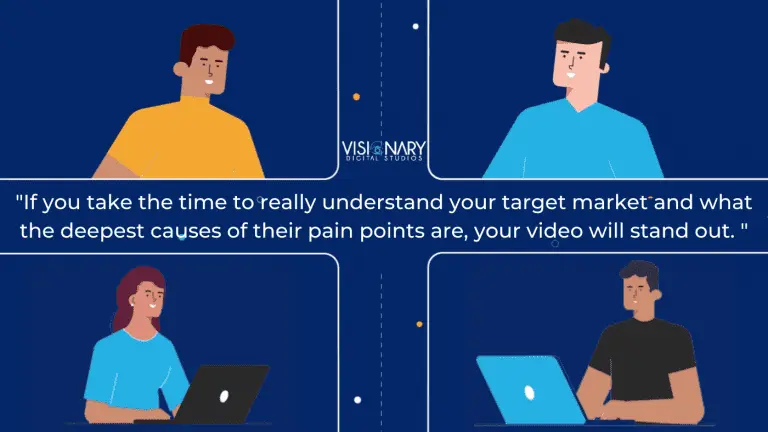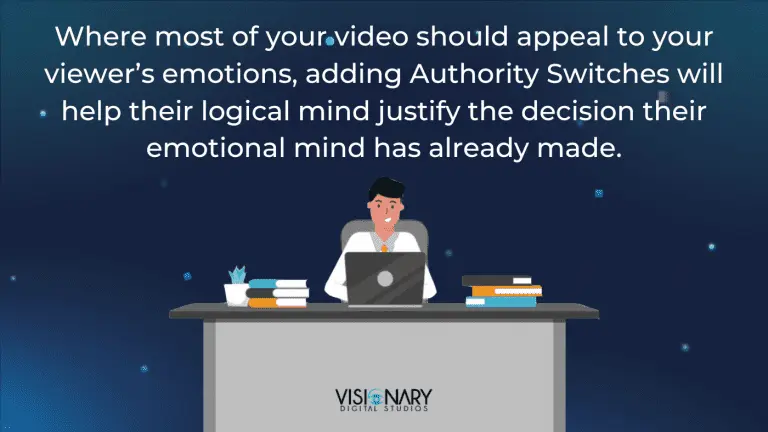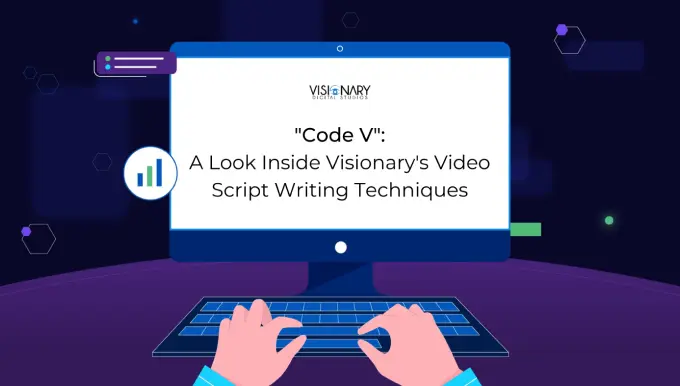Over time, The Visionary Team has cultivated a set of script writing formulas and techniques, affectionately known as “Code V”.
You’ll notice that the “Code V” techniques are not only in videos produced by Visionary, we also utilise Code V’s formula of persuasive writing in our online ads, websites and social posts too.
We’re continually refining our framework based on the research of leading copywriters – as well as our real-world experience launching hundreds of B2B marketing projects across 8 countries (and counting).
Vision
Always remember the goal of your video. Generally, it is to sell the next step in your sales process and build your brand. We’re very particular on this at Visionary – so much so that we’ll document a project vision and ensure it is shared every week in your Project Status Report.
The primary focus of your project is usually NOT to entertain viewers. Generally, B2B audiences would prefer to be INSPIRED by your knowledge.
Of course, it’s important that an appropriate hint of humour, education and quality production is included to keep your viewers engaged and convey your brand.
But don’t make the mistake of losing sight of your project vision…
Research
Research is by far the most important part of the scripting process.
But it’s often one of the most neglected!
The more precise and deep your understanding of your target market is, the more relevant and impactful your video script will be.
The first step is to understand who your perfect clients are. You want to make your video messages specifically for them. To learn about the depth with which you should understand your customers, see this article on Client Avatars.
Once you know who they are, you need to understand their pain points, benefits, and reasons for choosing you ahead of competitors – from THEIR perspective.
The best way to do this, is to get the intel directly from them through:
– Review your sales call notes
– Interview them
– Ask them to complete a Project Review questionnaire
– Review emails exchanged through your CRM
– Review their Social Media profiles
Ideally, if you really care enough about serving them effectively, you’ll do ALL of the above and more.
IMPORTANT TIP – don’t make the mistake of being too general. You want to be deep and specific, using the EXACT words that they use to describe their pain points and desires.
That Vital First 5 Seconds …
Arguably the most important part of your videos is the first 5 seconds. Captivating the ATTENTION of decision-makers by standing out amongst all the noise – and making an excellent first impression.
This becomes especially important when your target market is the C-Suite – they tend to make quick, sharp decisions about what content they’ll engage with.
This means the opening line of your video needs to be extremely well-strategised and executed. It should subtly call out or appeal to the exact psychology of your target audience. (For example. “When you’re a director who sells a complex B2B service …”)
If you achieve a powerful first 5 seconds, your audience will be primed to watch the rest of your video and truly absorb the message.
Build Desire
Build snowballing desire at the start of the video, by talking directly to the customer’s core problems, fears and frustrations.
But you need to go DEEP here.
Speaking to surface-level pain points will make your marketing sound like everyone-else’s.
If you take the time to really understand your target market and what the deepest causes of their pain points are, your video will really stand out. Your audience will FEEL understood by you.
You’ll stand out compared to your more surface-level competitors.
This is the ideal state for your audience to be in when you present them with your services.

Conversational
Video scripts should be written in conversational style so that the video is relatable to viewers and simple to digest.
Imagine you are at a cafe with your perfect customer and they’ve just asked “I’m thinking of buying X, what would you recommend?”.
The script should be written as if you are answering a question like this in conversation.
Address them directly as “you” or “your” throughout the video.
Use THEIR words and phrases. Enter the conversation already happening in their mind. The more you can mirror their language patterns, the more they will relate to your message.
And REMEMBER … make sure you remove any technical jargon or industry-specific terms that they wouldn’t understand.
Implement Powerful, Short Sentences
Use plenty of quick, snappy sentences to maintain engagement.
Of course technical services will require some detailed explaination and longer sentences, but to hold your audience’s attention, don’t forget…
Short sentences are powerful!Add them throughout your video script to reiterate important points and make bold statements.
For more tips on how video production can make your scripts more impactful, read about our B2B video production services here.
Are You Asking Questions To Hold Their Attention?
Use one or two questions throughout the video script to keep the viewer engaged and thinking about your message from THEIR own perspective.
Questions keep your viewers personally involved in the video rather than detaching from the message.
Specificity
Wherever possible, be specific and factual.
For example, “56% increase in sales” is so much more impactful, than “increase your sales”. Your script will be much more believable when you are precise in your language. Use numbers wherever it’s appropriate.
Incorporate “Authority Switches”
“Authority Switches” are anything that makes your audience understand that you are a credible, established expert they can trust.
Where most of your video should appeal to your viewer’s emotions, adding Authority Switches will help their logical mind justify the decision their emotional mind has already made.

Some examples of Authority Switches we incorporate into videos:
– Names or logos of well-known companies you have worked with
– Studies and statistics that support your product
– Years of experience in your field
– Client success statistics
– Awards and accreditations
– International exposure
Call To Action
Finish the script with a POWERFUL call to action.
After watching your video, your viewer will be in their most convinced state possible.
Let the viewer know exactly what they can do right now to take the next step in your sales process.
Optimal Video Length
There is no one-size-fits-all formula here. Generally, at Visionary we’ll produce videos between 60 seconds – 120 seconds long (but there are plenty of exceptions to this rule).
Longer videos allow you to:
– differentiate from similar competitors
– qualify prospects
– create a complete story/explanation
– break down complex concepts
Shorter videos are good for:
– less sophisticated audiences (eg. B2C)
– branding pieces – or, as an advanced technique
– to build an audience of video viewers during your online advertising
If you are creating your first Visionary Explainer Video, we’ll often prescribe 80 – 100 seconds, so that you can create an effective explanation and differentiation for your service.
As a general rule, a Voice Artist will perform at approximately 2.3 words per second. So a good benchmark to aim for is 190 – 240 words in your script.
VIDEO SCRIPT TEMPLATE
OK … here’s a template you can use to produce your own video script. The script structure takes your viewer on the following journey:
– 1 – [First line] Immediately captivating their Attention
– 2 – [25 – 30 seconds] Create desire by showing we understand their Pain Points better than any other marketing they have experienced
-3 – [60 Seconds] Introduce your product as the Amazing but Attainable, Solution
– 4 – [5 seconds] Add logical Credibility to everything the video has presented
– 5 – [Last line] Powerful Call To Action
Now, let’s talk about what to include in each step in more detail …
-
1 - ATTENTION: Capture Your Viewer's Focus
– In the first 3 seconds of the video, the viewer will make an unconscious decision about whether they will like the video, and whether they will trust the content. So … the first line needs to be hyper-relevant and jolt the viewer to attention. This is where great research really makes a difference.
– You could use a question that mirrors exactly what they are asking themselves in their mind.
– Or … make a bold statement that is highly relevant to them.
– Try to call them out in the opening line by mentioning their job title or an attribute highly specific to them. When done right, your audience will immediately lock in on your video amongst everything else on their newsfeed or browser tabs.
– Here’s an example from our project with GSN. This video was designed for Contact Centre Directors, looking to improve CX in their teams:
-
2 - PAIN POINTS: Build Snowballing Desire
– In the intro section of the video, we are looking to explain our audience’s problems at a precise level. If we can explain their problems to them, better than they can themselves, they will naturally ASSUME we have the solution. Powerful stuff.
– You need to be deep and specific here. Most companies get this wrong – they have not understood their audience’s pain points deeply enough. As a result, their videos, and their solutions, tend to sound just like their competitors.
– When you do this right your audience starts to feel an unconscious, snow-balling desire. “Wow … it’s like this video was designed exactly for me …”. It’s not a manipulative technique though – because when you’ve taken the time to understand your audience with this level of care, you will naturally be the best fit to serve them.
– The GSN example above is an excellent example of this principle in action.
-
3 - AMAZING ATTAINABLE SOLUTION
– Now, you can present your service as the amazing, but attainable solution to their problems.
– Often the best way to explain your service is step-by-step. This makes it FEEL simple for the viewer. For example, watch us break down a complex service into bite sized chunks, from 0:43 onwards, in our project with Single Source.
– Keep in mind … the majority of your video should still appeal to emotions, NOT logic. To do this, you’ll focus your message on the BENEFITS your audience will experience as a result of working with you.
-
4 - CREDIBILITY: Satisfy The Logical Mind
Once you’re getting towards the end of the video, your viewer should be FEELING desire to work with you.
Now it’s time to satisfy their logical mind.
Use 1 – 2 Authority Switches that your audience would find impressive. See the “Incorporate Authority Switches” section above for ideas.
-
5 - POWERFUL CALL TO ACTION
To end the video, advise the viewer on how to take the next step in your sales process. Remember to tell them the benefit they will receive from taking that action.
A Final Note From the Visionary Team …
The script is the most important part of your video.
Where possible, you want to have a professional script writer craft it for you. If that’s not possible, following the above guidelines will ensure you still produce a strategic script that stands out from the noise.
As long as you’ve done your research, and you understand your target market well … your script will be great.
If you’d like to see what a professionally crafted script looks like, we’ve broken down the psychology of the Visionary Digital Studios video script for you here:
THE SECRET SCRIPT-WRITING TECHNIQUES WE USED TO CRAFT OUR OWN EXPLAINER VIDEO SCRIPT

